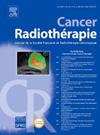碘造影剂对头颈部肿瘤体积调节放疗CT规划的剂量学影响
IF 1.4
4区 医学
Q4 ONCOLOGY
引用次数: 0
摘要
目的:头颈部肿瘤的体积调节弧线治疗需要准确描绘靶体积和危险器官。碘化造影剂可增强显像,但其对剂量分布的影响仍值得关注。传统上,剂量测定是在非对比CT扫描上进行的,以尽量减少剂量计算的差异。本研究评估了计划直接对增强CT扫描的剂量学影响。材料与方法采用体积调制辐射技术治疗的12例头颈部肿瘤(口腔、口咽、咽、筛、甲状腺)。靶和危险器官的划定和剂量计算在增强CT扫描上进行,随后转移到不进行正规化的非增强CT扫描上。高风险计划目标体积的处方剂量为60至70戈瑞,低风险计划目标体积的处方剂量为54戈瑞,分为30至33份。使用AAA剂量计算算法,在Eclipse®(15.6版本)上进行体积调制弧治疗计划,同时集成boost。评估了危险器官和计划靶体积的剂量学变化。结果下颌骨、喉部、腮腺和咽收缩肌的平均剂量变化范围为0.02 Gy (0.10%) ~ 0.16 Gy(0.38%)。椎管、脑干、臂丛和颈动脉的平均D2 %变化范围为0.05 Gy(0.17%)至0.16 Gy(0.46%)。没有发现有危险器官的变异具有统计学或临床意义。对于规划目标量,规定剂量95%等剂量的覆盖率变化始终小于1%。最大剂量的最大变化是减少0.6 Gy,占0.8%。结论:与非对比CT扫描相比,直接在增强CT扫描上进行体积调制弧线治疗计划可使剂量学变化最小(小于1%)。这种方法可以通过消除双CT采集和优化治疗准备来简化临床工作流程。本文章由计算机程序翻译,如有差异,请以英文原文为准。
Dosimetric impact of iodinated contrast agent on planning CT for volumetric-modulated radiotherapy of head and neck cancer
Purpose
Volumetric-modulated arc therapy for head and neck cancers requires accurate delineation of target volumes and organs at risk. Iodinated contrast agents enhance visualization, but their impact on dose distribution remains a concern. Traditionally, dosimetry is performed on non-contrast CT scans to minimize dose calculation discrepancies. This study evaluates the dosimetric impact of planning directly on contrast-enhanced CT scans.
Material and methods
Twelve patients with head and neck cancers (oral cavity, oropharynx, pharyngolarynx, ethmoid, thyroid) treated using volumetric-modulated radiation technique were included. Target and organs at risk delineation and dose calculation were performed on contrast-enhanced CT scans and subsequently transferred to non-contrast CT scans without renormalization. Prescribed doses for high-risk planning target volume were 60 to 70 Gy, for low-risk planning target volume 54 Gy, in 30 to 33 fractions. Volumetric-modulated arc therapy planning was performed on Eclipse® (version 15.6), with simultaneous integrated boost, using the AAA dose calculation algorithm. Dosimetric variations in organs at risk and planning target volumes were assessed.
Results
Mean variations of mean dose for organs at risk mandible, larynx, parotid glands, and pharyngeal constrictor muscle ranged from 0.02 Gy (0.10 %) to 0.16 Gy (0.38 %). Mean D2 % variations for spinal canal, brainstem, brachial plexus, and carotid arteries ranged from 0.05 Gy (0.17 %) to 0.16 Gy (0.46 %). None of the variations for organs at risk were found to be statistically or clinically significant. For planning target volumes, variations in coverage by the 95 % isodose of the prescribed dose were always less than 1 %. The maximum variation of maximum dose was a decrease of 0.6 Gy, representing 0.8 %.
Conclusion
Performing volumetric-modulated arc therapy planning directly on contrast-enhanced CT scans leads to minimal dosimetric variations (less than 1 %) compared to non-contrast CT scans. This approach could streamline clinical workflows by eliminating the need for dual CT acquisitions and optimizing treatment preparation.
求助全文
通过发布文献求助,成功后即可免费获取论文全文。
去求助
来源期刊

Cancer Radiotherapie
医学-核医学
CiteScore
2.20
自引率
23.10%
发文量
129
审稿时长
63 days
期刊介绍:
Cancer/radiothérapie se veut d''abord et avant tout un organe francophone de publication des travaux de recherche en radiothérapie. La revue a pour objectif de diffuser les informations majeures sur les travaux de recherche en cancérologie et tout ce qui touche de près ou de loin au traitement du cancer par les radiations : technologie, radiophysique, radiobiologie et radiothérapie clinique.
 求助内容:
求助内容: 应助结果提醒方式:
应助结果提醒方式:


